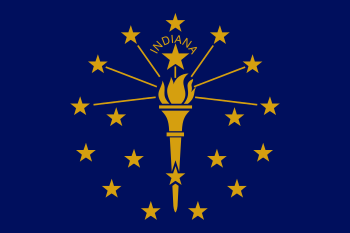John Hanna (Indiana)
John Hanna (September 3, 1827 – October 24, 1882) was a United States Representative and United States Attorney from Indiana.
Early years
.jpg)
Born near Indianapolis, he pursued classical studies and graduated from the Indiana Asbury University (now DePauw University) in 1850. He studied law, was admitted to the bar, and commenced practice in Greencastle. He was mayor of Greencastle from 1851 to 1854.
Bleeding Kansas
He moved to Kansas in 1857 and in December of that year was elected to its Territorial legislature.[1] In 1858, as Chairman of the Judiciary Committee, he introduced and secured passage (over the Governor's veto) of an act that repealed the 1855 law "To punish offenses against slave property", effectively making expansion of slavery in Kansas impossible.[2][3] He returned to Indiana in 1858.
U.S. Attorney
In 1860, he was an Indiana elector for Abraham Lincoln.[4] He was appointed United States Attorney for Indiana by President Lincoln in 1861.[5] Active in pursuing disloyalty claims against Southern sympathizers, he appeared for the United States in Ex Parte Milligan prior to the appeal to the U. S. Supreme Court.[6] Reappointed by President Andrew Johnson in 1865,[7] he was removed by him in 1866 after he publicly denounced the president at a meeting in Indianapolis.[8][9] He then retired to private law practice in partnership with civil war general Frederick Knefler.
Congressman
He was elected as a Republican to the Forty-fifth Congress in 1876, defeating the Democratic incumbent 19,534 to 18,236, as the Greenback party candidate polled 1,595 votes. He held office from March 4, 1877, to March 3, 1879, having been defeated in his bid for reelection in 1878 by Gilbert De La Matyr, who had been nominated by both the Democratic and Greenback parties, 18,727 to 17,881.[10]
Death
He died in Plainfield, Indiana; interment was in Forest Hill Cemetery, Greencastle.
References
- United States Congress. "John Hanna (id: H000160)". Biographical Directory of the United States Congress.
- John Hanna, in The History of Hendricks County(Chicalgo. Interstate Publishing. 1885) pp. 619–622
- ↑ Daniel Webster Wilder, The Annals of Kansas. Arno Press. NY 1975. pp. 192-193
- ↑ Transactions of the Kansas State Historical Society, 1907-1908, Vol. X. pp. 169-211.
- ↑ The History of Hendricks County(Chicalgo. Interstate Publishing. 1885) pp. 619-622.
- ↑ Records of the Indiana Secretary of State
- ↑ Journal of the Executive Proceedings of the Senate of the United States of America, 1858-1861, p. 320.
- ↑ Davis, David/ U.S. Supreme Court Justice. Ex Parte Milligan. 71 U,S, 2 (4 Wall,)
- ↑ Journal of the Executive Proceedings of the Senate of the United States of America, Vol. 14
- ↑ The History of Hendricks County(Chicalgo. Interstate Publishing. 1885) pp. 619-622.
- ↑ A Century of Lawmaking for a New Nation:U.S. Congressional Documents and Debates, 1774-1875, Journal of the Executive Proceedings of the Senate of the United States, Vol. 16, P, 55 The Biographical Directory of the U.S. Congress states he served until 1869. However, as the citation in the Senate Executive Journal shows, his replacement was nominated December 14, 1866.
- ↑ Michael J. Dubin. United States Congressional Elections, 1788-1997. McFarland & Co., Inc. 1998. pp237 & 244
| United States House of Representatives | ||
|---|---|---|
| Preceded by Franklin Landers |
Member of the U.S. House of Representatives from Indiana's 7th congressional district March 4, 1877 – March 3, 1879 |
Succeeded by Gilbert De La Matyr |

